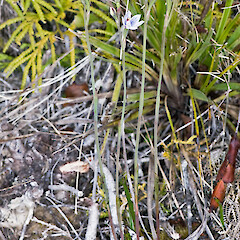Thelymitra ×dentata
Common name
hybrid sun orchid
Synonyms
None (first described as species in 1969, shown to be a hybrid in 1998).
Family
Orchidaceae
Flora category
Vascular – Native
Endemic taxon
Yes
Endemic genus
No
Endemic family
No
Structural class
Orchids
Chromosome number
2n = 45–46.
Current conservation status
The conservation status of all known New Zealand vascular plant taxa at the rank of species and below were reassessed in 2017 using the New Zealand Threat Classification System (NZTCS) – more information about this can be found on the NZTCS website. This report includes a statistical summary and brief notes on changes since 2012 and replaces all previous NZTCS lists for vascular plants.
Please note, threat classifications are often suggested by authors when publications fall between NZTCS assessment periods – an interim threat classification status has not been assessed by the NZTCS panel.
- Conservation status of New Zealand indigenous vascular plants, 2017 . 2018. Peter J. de Lange, Jeremy R. Rolfe, John W. Barkla, Shannel P. Courtney, Paul D. Champion, Leon R. Perrie, Sarah M. Beadel, Kerry A. Ford, Ilse Breitwieser, Ines Schönberger, Rowan Hindmarsh-Walls, Peter B. Heenan and Kate Ladley. Department of Conservation. Source: NZTCS and licensed by DOC for reuse under the Creative Commons Attribution 4.0 International licence.
2012 | Not Threatened
Previous conservation statuses
2009 | Not Threatened
2004 | Not Threatened
Distribution
Endemic. New Zealand: North Island (sporadic from Waikato to Wellington), South Island (along portions of the West Coast). Uncommon.
Habitat
Coastal to montane areas (up to 800 m a.s.l.). In open shrubland, gumland vegetation, peat bogs and along ridge lines in mature forest. Always found in the vicinity of Thelymitra longifolia J.R.Forst. et G.Forst. and T. pulchella Hook.f.—the parents of this sporadically occurring hybrid.
Detailed description
Robust terrestrial, tuberous, glabrous, spring to summer-green perennial herb, solitary or growing in small colonies of 4–10 plants arising through vegetative extension. Plants at flower up to 600 mm tall. Stem robust, fleshy, erect 2.5–4.8 mm diameter. Leaf firmly fleshy to subcoriaceous, rather thick, erect to suberect, 80–200 × 10–20 mm, shallowly channelled. Inflorescence a (1)–6-flowered raceme. Flower 10–15 mm diameter, segments usually blue, lavender or pink, petals, labellum and dorsal sepals prominently striped with dark blue. Sepals and petals subsimilar, broad, slightly obovate. Labellum oblong-obovate. Column erect 6.5–8.0 mm tall, blue, lavender or pink; post-anther lobe taller than anther, slightly or prominently cucullate, and usually tuberculate towards apex, basal portion to mid section dark red grading to yellow toward apex; column-arms thickened about nerve, flanged about the base with delicate pinkish lobes, teeth or fimbriae, that mostly extend down the front margin of the column-wing; the arms bent inwards such that the cilia meet just above anther apex; cilia copious, in globose clusters, initially pale yellow maturing brown with age.
Manaaki Whenua Online Interactive Key
Similar taxa
Most like Thelymitra pulchella Hook.f. one of its parents, from which it differs by the inconspicuous rather than obvious, column-arm teeth that extend more or less down the front margin of the column-arm wing rather than elongate into branched fimbriae; and by the consistent presence of globose masses of yellow cilia. In T. pulchella the column arms may or may not be ciliate, and the yellow cilia are always sparse. Unlike T. pulchella, whose post-anther lobe rarely extended above the anther, T. ×dentata has a prominent, hooded post-anther lobe that is consistently taller than the anther. Thelymitra ×dentata is distinguished from other indigenous Thelymitra with striped flowers, by its failure to produce capsules following flowering because it is completely sterile.
Flowering
November–January
Flower colours
Blue, Red/Pink
Fruiting
Seed not produced (sterile hybrid)
Propagation technique
Very easily grown in a sunny, well drained site. It can only be grown by vegetative means as it is sterile. Although easily cultivated, like all orchids it should not be removed from the wild.
Threats
Not Threatened. A sterile hybrid, which is listed here only because in the New Zealand Flora Series (Flora Vol. 2, Moore & Edgar 1970) it was regarded as a species. Further it is likely to be found wherever its parent species are sympatric, and so cause confusion unless a description is provided.
Etymology
thelymitra: Woman’s hat
dentata: Toothed
Where To Buy
Not commercially available.
Attribution
Description adapted from Moore and Edgar (1970).
References and further reading
Moore LB, Edgar E. 1970. Flora of New Zealand, Volume II. Indigenous Tracheophyta: Monocotyledones except Gramineae. Government Printer, Wellington, NZ. 354 p.
Rolfe JR, de Lange PJ. 2010. Illustrated guide to New Zealand sun orchids, Thelymitra (Orchidaceae). Jeremy Rolfe, Wellington, NZ. 57 p.
NZPCN Fact Sheet citation
Please cite as: de Lange, P.J. (Year at time of access): Thelymitra ×dentata Fact Sheet (content continuously updated). New Zealand Plant Conservation Network. https://www.nzpcn.org.nz/flora/species/thelymitra-dentata/ (Date website was queried)




